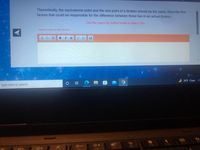
Chemistry
10th Edition
ISBN: 9781305957404
Author: Steven S. Zumdahl, Susan A. Zumdahl, Donald J. DeCoste
Publisher: Cengage Learning
expand_more
expand_more
format_list_bulleted
Concept explainers
Question
Please type this, do not write it on a paper.

Transcribed Image Text:Theoretically, the equivalence point and the end point of a titration should be the same. Describe four
factors that could be responsible for the difference between these two in an actual titration.
Use the paperclip button below to attach files.
* Student can enter max 350DD characters
B
U
Type here to search
39°F Clear
Fio
F11
F6
F8
立
Expert Solution
This question has been solved!
Explore an expertly crafted, step-by-step solution for a thorough understanding of key concepts.
Step by stepSolved in 2 steps

Knowledge Booster
Learn more about
Need a deep-dive on the concept behind this application? Look no further. Learn more about this topic, chemistry and related others by exploring similar questions and additional content below.Similar questions
- PowerPoint File Edit View Insert Format Arrange Tools Slide Show Window Help 37% O Mon 11:48 PM Aman Getu Q AutoSave P Lab 1 Problem Solving Using The Scientific Method OFF Home Insert Draw Design Transitions Animations Slide Show Review View Tell me A Share Comments X Cut Layout v Arial 18 A Shape Fill v Сору v Reset New Slide A Design Ideas Convert to Picture Shapes Quick Styles Paste ab x X, A v Aa v Тext Arrange Shape Outline v Format Section v SmartArt Воx 1 Lab 1 Problem Solving Using the Scientific Method STEP 2 You add three drops of Dye X to the clear liquids in each bottle and observe what happens. Introduction to Biology- BIO-105 Problem Solving Using the Scientific Method Objective Biologists and other scientists continually study the world around them and identify problems that need to be solved scientific method is a process that enable scientists to systematically solve problems by making careful observation: asking questions, formulating hypotheses and devising…arrow_forwardQuestion 12 and 13 short answers pleasearrow_forwardWater + potassium = ANSWER IN WORDS ONLY!!!arrow_forward
- Match the words in the left column to the appropriate blanks in the sentences on the right. Make certain each sentence is completed before submitting your answer. ARE significant ARE significant are NOT significant are ambiguous 1. Zeros at the end of a number with a decimal point 2. Zeros in the middle of two other numbers 3. Zeros at the end of a number with no decimal point 4. Zeros at the beginning of a number Reset Helparrow_forwarda_____ is a group of atoms bonded in a specific pattern and is the reactive portion of an organic molecule .arrow_forwardQuestion 4. In the course material you have been introduced to multiple charging for electrospray spectra. Each peak in the spectrum below can be used to provide a measure of the mass of this protein, you can work out the charge associated with each peak, and measures can be averaged to find the overall mass. Use simultaneous equations to find the charge associated with each peak in the spectra below, which will allow you to calculate the average mass of each species. Include an estimate of the error associated with this measure. 659.8 714.7 779.5 857,4 952.6 1071.5 BMW Sparrow_forward
- Question 4. In the course material you have been introduced to multiple charging for electrospray spectra. Each peak in the spectrum below can be used to provide a measure of the mass of this protein, you can work out the charge associated with each peak, and measures can be averaged to find the overall mass. Use simultaneous equations to find the charge associated with each peak in the spectra below, which will allow you to calculate the average mass of each species. Include an estimate of the error associated with this measure. x105 659.8 714.7 779.5 857.4 952.6 1000 Page 3 of 3 1071.5 1100 1200 1300 +MS, 01-13min (779) myzarrow_forward_Na2SO4 + _AlCl3 => _Al2(SO4)3 + _NaClarrow_forwardPlease don't provide handwriting solutions...arrow_forward
- Subject: chemistryarrow_forwardWhat is polarity and how is polarity related to how chromatography works?arrow_forward7. You can see an MSDS below. Please answer the following questions related to the MSDS. a) What is the name of this chemical? b) What should you do if someone drinks the chemical? c) Would this chemical catch on fire if it was exposed to flames? d) If this chemical gets in your eye what should you do? e) What color is this chemical? f) What should you do if someone spills a small amount of the chemical?arrow_forward
arrow_back_ios
SEE MORE QUESTIONS
arrow_forward_ios
Recommended textbooks for you
 ChemistryChemistryISBN:9781305957404Author:Steven S. Zumdahl, Susan A. Zumdahl, Donald J. DeCostePublisher:Cengage Learning
ChemistryChemistryISBN:9781305957404Author:Steven S. Zumdahl, Susan A. Zumdahl, Donald J. DeCostePublisher:Cengage Learning ChemistryChemistryISBN:9781259911156Author:Raymond Chang Dr., Jason Overby ProfessorPublisher:McGraw-Hill Education
ChemistryChemistryISBN:9781259911156Author:Raymond Chang Dr., Jason Overby ProfessorPublisher:McGraw-Hill Education Principles of Instrumental AnalysisChemistryISBN:9781305577213Author:Douglas A. Skoog, F. James Holler, Stanley R. CrouchPublisher:Cengage Learning
Principles of Instrumental AnalysisChemistryISBN:9781305577213Author:Douglas A. Skoog, F. James Holler, Stanley R. CrouchPublisher:Cengage Learning Organic ChemistryChemistryISBN:9780078021558Author:Janice Gorzynski Smith Dr.Publisher:McGraw-Hill Education
Organic ChemistryChemistryISBN:9780078021558Author:Janice Gorzynski Smith Dr.Publisher:McGraw-Hill Education Chemistry: Principles and ReactionsChemistryISBN:9781305079373Author:William L. Masterton, Cecile N. HurleyPublisher:Cengage Learning
Chemistry: Principles and ReactionsChemistryISBN:9781305079373Author:William L. Masterton, Cecile N. HurleyPublisher:Cengage Learning Elementary Principles of Chemical Processes, Bind...ChemistryISBN:9781118431221Author:Richard M. Felder, Ronald W. Rousseau, Lisa G. BullardPublisher:WILEY
Elementary Principles of Chemical Processes, Bind...ChemistryISBN:9781118431221Author:Richard M. Felder, Ronald W. Rousseau, Lisa G. BullardPublisher:WILEY

Chemistry
Chemistry
ISBN:9781305957404
Author:Steven S. Zumdahl, Susan A. Zumdahl, Donald J. DeCoste
Publisher:Cengage Learning

Chemistry
Chemistry
ISBN:9781259911156
Author:Raymond Chang Dr., Jason Overby Professor
Publisher:McGraw-Hill Education

Principles of Instrumental Analysis
Chemistry
ISBN:9781305577213
Author:Douglas A. Skoog, F. James Holler, Stanley R. Crouch
Publisher:Cengage Learning

Organic Chemistry
Chemistry
ISBN:9780078021558
Author:Janice Gorzynski Smith Dr.
Publisher:McGraw-Hill Education

Chemistry: Principles and Reactions
Chemistry
ISBN:9781305079373
Author:William L. Masterton, Cecile N. Hurley
Publisher:Cengage Learning

Elementary Principles of Chemical Processes, Bind...
Chemistry
ISBN:9781118431221
Author:Richard M. Felder, Ronald W. Rousseau, Lisa G. Bullard
Publisher:WILEY